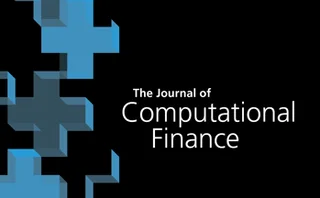Original research
Hypothetical yield curve scenarios for credit stress testing
In this paper, we discuss a set of hypothetical yield curve shift scenarios generated by applying extreme value distributions and a shaping procedure. These statistically derived hypothetical stress scenarios could be susceptible to model risk, leading…
Decomposing supply shocks in the US electricity industry: evidence from a time-varying Bayesian panel vector autoregression model
This paper investigates spillovers between electricity supply shocks and US growth, using monthly data from forty-eight US states from January 2001 to September 2016, and employs a novel strategy for electricity supply shocks based on a time-varying…
Corporate default risk modeling under distressed economic and financial conditions in a developing economy
The authors create stepwise logistic regression models to predict the probability of default for private nonfinancial firms under distressed financial and economic conditions in a developing economy. Their main aim is to identify and interpret the…
A joint model of failures and credit ratings
The authors propose a novel framework for credit risk modeling, where default or failure information and rating or expert information are jointly incorporated in the model.
Benchmarking loss given default discount rates
This paper provides a theoretical and empirical analysis of alternative discount rate concepts for computing loss given default rates using historical bank workout data.
The impact of corporate social and environmental performance on credit rating prediction: North America versus Europe
The authors quantify the extent to which the quality of credit rating predictions improves by integrating measures of corporate social performance (CSP) in an established credit risk model. Their analysis provides comprehensive evidence of the…
Fund size and the stability of portfolio risk
This paper examines the relationship between portfolio size and the stability of mutual fund risk measures, presenting evidence for economies of scale in risk management.
Network sensitivity of systemic risk
Here, we address the more general problem of how shock propagation dynamics depend on the topological details of the underlying network. To this end, we consider different realistic network topologies, all consistent with balance sheet information…
A k-means++-improved radial basis function neural network model for corporate financial crisis early warning: an empirical model validation for Chinese listed companies
This paper aims to simplify the early warning model for financial crises by collecting and analyzing the financial data of Chinese special treatment (ST) companies, normally listed companies and cancel special treatment (CST) companies.
Elliptical and Archimedean copula models: an application to the price estimation of portfolio credit derivatives
This paper explores the impact of elliptical and Archimedean copula models on the valuation of basket default swaps.
The use of range-based volatility estimators in testing for Granger causality in risk on international capital markets
This study utilizes the extreme value theory (EVT) approach to compare the performance of a wide variety of range-based volatility estimators in the analysis of causality in risk between emerging and developed markets.
Neural networks for option pricing and hedging: a literature review
This paper provides a comprehensive review of the field of neural networks, comparing articles in terms of input features, output variables, benchmark models, performance measures, data partition methods and underlying assets. Related work and…
Economic policy uncertainty, investors’ attention and US real estate investment trusts’ herding behaviors
Using a quantile regression model, this study examines economic policy uncertainty and investors’ attention for policy risk on US real estate investment trusts’ (REITs’) herding behaviors.
Benchmarking operational risk stress testing models
This paper outlines several approaches to benchmarking operational loss projections under stressed scenarios using both accounting metrics and historical loss experience.
Eigenportfolios of US equities for the exponential correlation model
In this paper, the eigendecomposition of a Toeplitz matrix populated by an exponential function in order to model empirical correlations of US equity returns is investigated.
Dynamic refinement of the term structure: time-homogeneous term structure modeling
The author considers a classical term structure model framework, ie, a Heath–Jarrow–Morton framework, on a time-discrete tenor, such as the London Interbank Offered Rate market model, using a sequence of tenor discretizations, where the tenors are valid…
The econophysics of asset prices, returns and multiple expectations
The author models interactions between financial transactions and expectations and describe asset pricing and return disturbances.
Gaussian process regression for derivative portfolio modeling and application to credit valuation adjustment computations
The authors present a multi-Gaussian process regression approach, which is well suited for the over-the-counter derivative portfolio valuation involved in credit valuation adjustment (CVA) computation.
Optimal dynamic strategies on Gaussian returns
It is hoped that this paper will form a foundational approach to the study of dynamic strategies and how to optimize them. We make efforts to understand their properties without claiming to understand why they work (ie, why there are stable…
What is essential is invisible to the eye: prioritizing near misses to prevent future disasters
Near misses represent a primary information source to analyze the operational risk exposure of a company, since they can reveal gaps in the control environment. The model proposed in this paper aims at identifying the most dangerous events that could…
IFRS 9 compliant economic adjustment of expected credit loss modeling
This paper presents an International Financial Reporting Standard 9 (IFRS 9) compliant solution related to expected credit loss modeling.
Is trading indicator performance robust? Evidence from scenario building
This paper challenges widely applied trading indicators with regard to their ability to generate a robust performance.
High-order approximations to call option prices in the Heston model
In the present paper, a decomposition formula for the call price due to Alòs is transformed into a Taylor-type formula containing an infinite series with stochastic terms. The new decomposition may be considered as an alternative to the decomposition of…
An emergent taxonomy for operational risk: capturing the wisdom of crowds
In this paper, the author takes a data-driven approach and combines the individual active taxonomies of sixty large financial institutions (fifty-eight for construction and two for validation) to create a coherent new reference taxonomy: the ORX…




